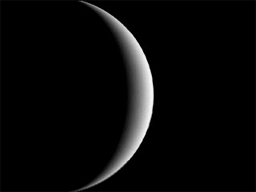Emily Lakdawalla • Apr 04, 2008
Does Venus Express smell volcanoes?
One of the goals of ESA's Venus Express mission is to hunt down clues to the question of whether Venus is currently volcanically active or not. Although it doesn't have a handy catchphrase, the question of the timing of Venus' volcanism is kind of like the "Follow the Water" mantra that has driven recent Mars missions -- it's one of those really important, high-level, mission-driving science goals that turns out to be really tricky to answer because of conditions at Venus. On Mars, the question was difficult to address because the entire planet is covered with a layer of pretty much homogeneous dust, which obscures the spectral signals from minerals that formed in water. But, over time, as we've explored Mars from space and from the surface with increasingly high-resolution instruments with increasing ability to discern tiny differences among surface properties, we've gotten pretty good at locating deposits of unusual minerals and rock formations that pretty much require liquid water to have been present. At Mars, they're now moving on from "Follow the Water" to investigating a subset of those once-watery places that might once have been habitable. (They don't have a new mantra yet; somebody needs to invent one.)
Only Europe has considered Venus worth a visit, and Venus Express has been there for just about two years. Venus' global cloud cover is an even more difficult problem to deal with than Mars' global dust cover. The clouds and haze scatter light, so no matter how powerful your camera you can only get a very blurry look at the surface below. (It's the same problem Cassini has at Titan.) Radar can of course get through the clouds, and that's what many of the Venera orbiters and Magellan used to study Venus' surface; I hope to see another radar instrument sent to Venus in the next decade or two that might be able to get a data set to compare with Magellan to look for new lava flows. In the meantime, though, if you want to look for active volcanism you need to look for it in other ways than with cameras.
Venus Express has been searching for active volcanism in two ways. One is to look for abnormal amounts of heat radiating from the surface, something I've written about before. The problem there is that Venus has topography that varies nearly as much as Earth's, and just like on Earth the tops of mountains are much colder places than lower altitudes, so to look for heat flow you need to correct your heat measurements for the effects of topography, and this is a difficult process.
Another way was just reported today in a release from the Venus Express mission: they are searching for the gaseous by-products of volcanoes in Venus' atmosphere. Now, it's widely believed that Venus' thick atmosphere, full of carbon dioxide and sulfur compounds, resulted in part from the extreme amount of volcanic activity it has evidently experienced in the past. So how can you tell if there's new volcanism going on? Well, although carbon dioxide tends to stick around in Venus' atmosphere, another common volcanic gas, sulfur dioxide, does not; it reacts with the rocks on Venus' surface and so gets removed. On Earth, sulfur dioxide is removed by a similar process, but it helps that there's so much water around, so sulfur dioxide gets lost really fast. On Venus, the lack of water means that it takes on average about 20 million years for a sulfur dioxide molecule to be removed from the atmosphere.
Venus Express has detected sulfur dioxide in Venus' atmosphere, no surprise. What is surprising is that the amount that Venus Express sees varies very rapidly. The release states "The SPICAV (Spectroscopy for Investigation of Characteristics of the Atmosphere of Venus) instrument analyses the way starlight or sunlight is absorbed by Venus's atmosphere. The absorbed light tells scientists the identity of the atoms and molecules found in the planet's atmosphere. This technique works only in the more tenuous upper atmosphere, above the clouds at an altitude of 70


 Explore Worlds
Explore Worlds Find Life
Find Life Defend Earth
Defend Earth


